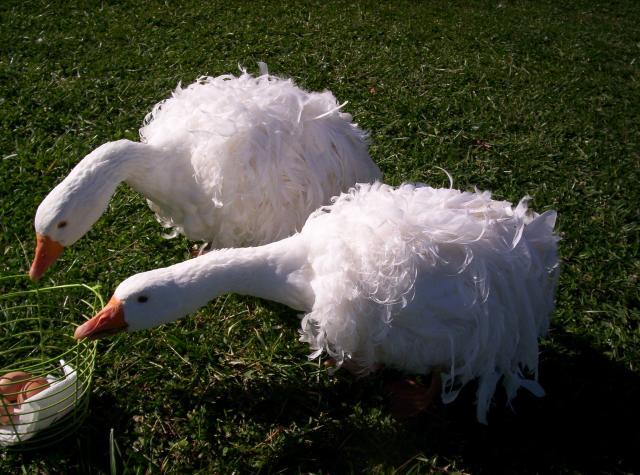- Thread starter
- #11
Quote:
There looks to be an adult trio with maybe another female in back who all look good for this time of year. Nice, nice type as well. We don't see enough like this. Not discounting Banter's experiences with her colored stock but the usual is that Sebastopols will feather out very nicely, or as nicely as genetics allow, their first autumn. Late autumn is what I should say for many. The problem with adults from many strains and outcrossed matings is that breast feather especially is never seem again as it was on the babies. What was long baby curl shortens up, flattens out and we can see birds go from curly to quilted or lightly furrowed. The goal, no matter the color, is to have the right size and type just covered with long wide curls EVERYWHERE even on older birds. It's a genetic characteristic that some birds/strains have and many do not. The well raised looking young bird pictured shows plenty of feather and curl though higher up towards or on to the neck would be nice. Trick is to see if he retains it as an adult.
thank you for the kind words Dave. I end up only keeping 1-2 a year becasue I am trying to cull for everything at one time. Not sure if that is right or wrong, but I am still working on the long feathers on the breast. They have curl, just want them longer like you said.
What is the secret on sexing them by looks....LOL We all want to know. That is my gander second from the left by the way, and a 2010 gosling to the right of him and the very back left corner.
I like the head, neck and body on the female in the front left, just wish she had more feathering on the chest. She is 4 years old.
There looks to be an adult trio with maybe another female in back who all look good for this time of year. Nice, nice type as well. We don't see enough like this. Not discounting Banter's experiences with her colored stock but the usual is that Sebastopols will feather out very nicely, or as nicely as genetics allow, their first autumn. Late autumn is what I should say for many. The problem with adults from many strains and outcrossed matings is that breast feather especially is never seem again as it was on the babies. What was long baby curl shortens up, flattens out and we can see birds go from curly to quilted or lightly furrowed. The goal, no matter the color, is to have the right size and type just covered with long wide curls EVERYWHERE even on older birds. It's a genetic characteristic that some birds/strains have and many do not. The well raised looking young bird pictured shows plenty of feather and curl though higher up towards or on to the neck would be nice. Trick is to see if he retains it as an adult.
thank you for the kind words Dave. I end up only keeping 1-2 a year becasue I am trying to cull for everything at one time. Not sure if that is right or wrong, but I am still working on the long feathers on the breast. They have curl, just want them longer like you said.
What is the secret on sexing them by looks....LOL We all want to know. That is my gander second from the left by the way, and a 2010 gosling to the right of him and the very back left corner.
I like the head, neck and body on the female in the front left, just wish she had more feathering on the chest. She is 4 years old.




